|
1874 Icelandic parliamentary election
Parliamentary elections were held in Iceland in the autumn of 1874.[1] The elections were the first after the introduction of a new constitution, which granted legislative and financial powers to the Althing and increased the number of members from 27 to 36.[2][3] Electoral systemThe 30 elected members of the Althing were elected from single or double member constituencies by a three-round system; in the first two rounds, a candidate receiving a majority of the vote was elected; if seats were still unfilled after the second round, a third round was held using first-past-the-post voting.[3] Voting took place at a single polling place in each constituency and was done publicly.[3] A further six members were appointed to the upper house by the Danish monarch.[2] Suffrage was limited to men aged 25 or over who were not in receipt of poor relief and who met one of several set requirements including being a civil servant, being a graduate of a university or seminary, or meeting various tax criteria (for farmers, paying more than the minimum tax; for burghers or fishermen, paying eight króna of local taxes; for property owners, paying twelve króna of local property taxes).[2] This limited the number of voters to 6,183 from a population of 70,595.[4] Results1,211 of the 6,183 registered voters participated in the elections.[4] All candidates were independents, as there were no political parties in Iceland at the time.[3] References
|
